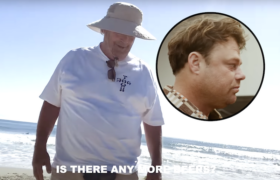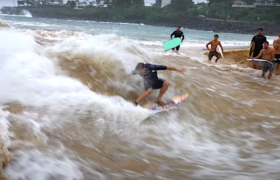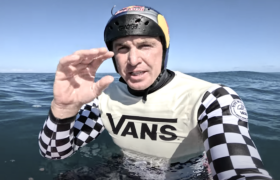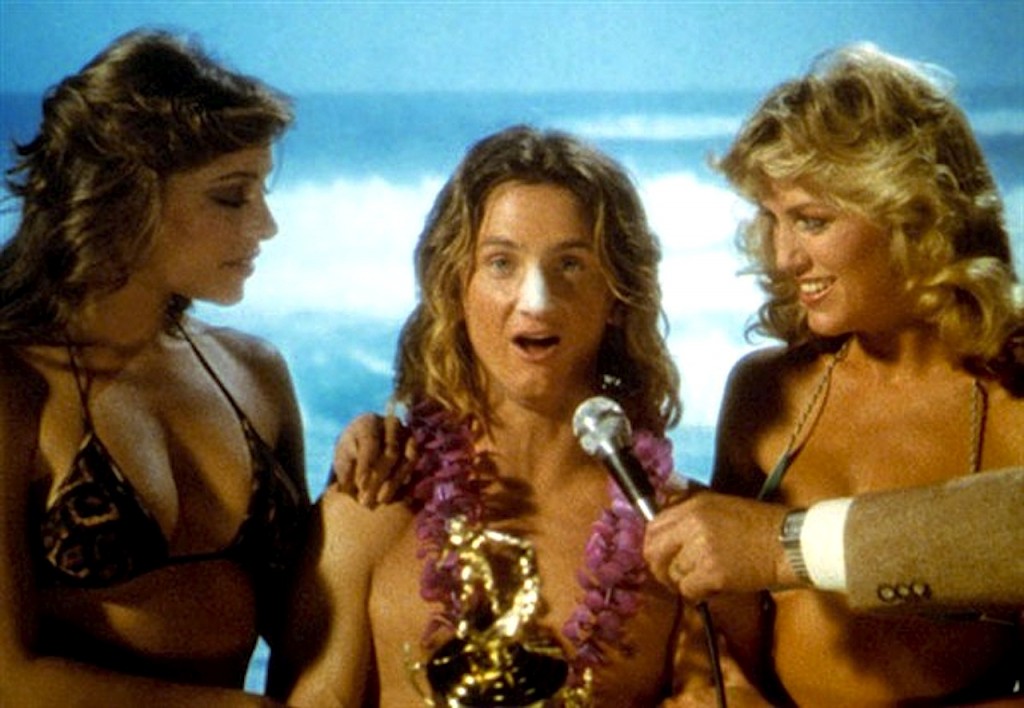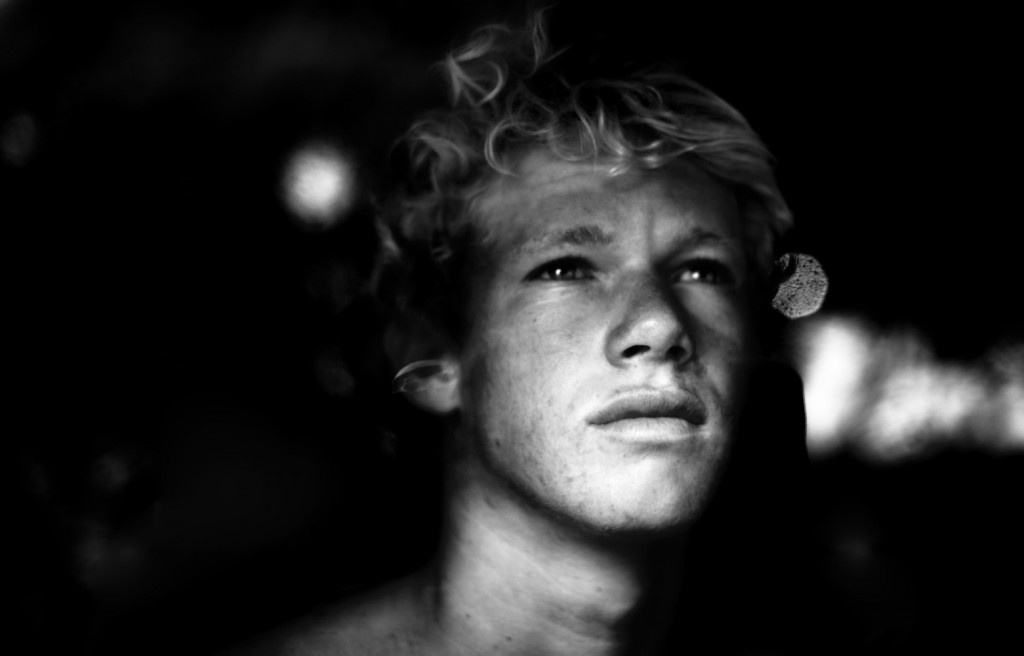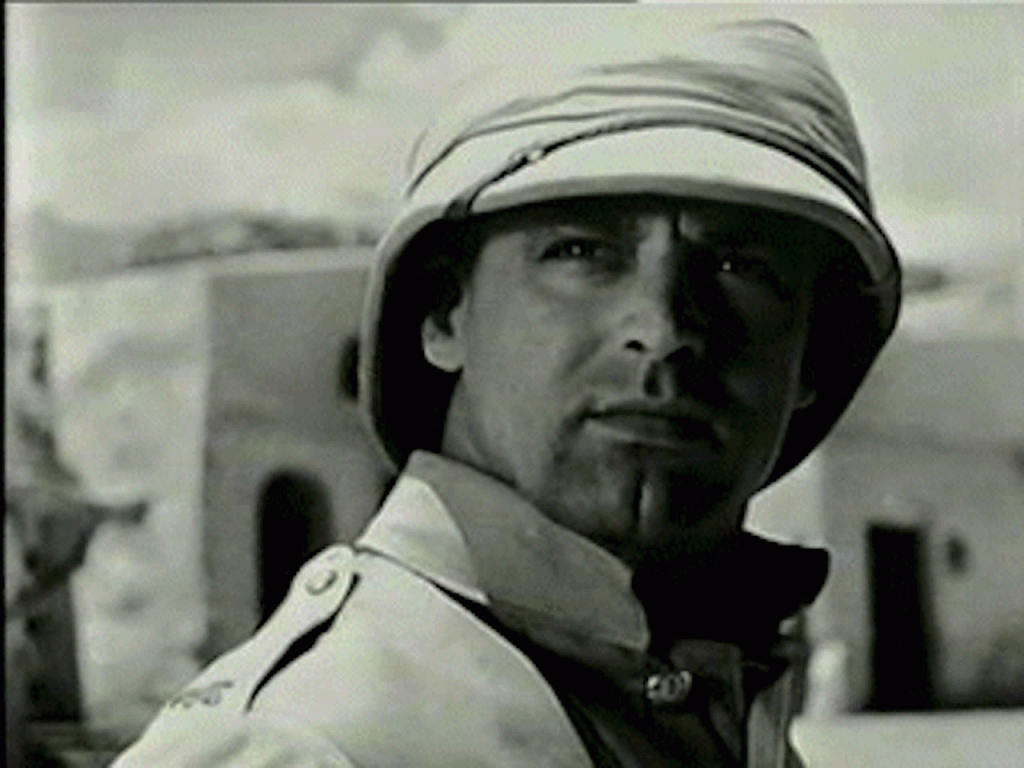Not just any bodyboarder, though. Paul Roach! THE Paul Roach!
He comes screaming down the line like a slippy, slidey salsa dancer. Like a liquid torso’d Cirque du Soleil acrobat. Onlookers, standing on the beach, gape. “How is he throwing so much spray? How is he snapping so damned hard? A 360? Right in the middle of the wave after that snap? How is he getting so barreled? Isn’t this wave a dumpy three-footer?” He blows apart their preconceptions. Some of the onlookers, though, bury their awe beneath a rude and heavy sneer. “Booger.” “Fucking speed bump.” “Dick-dragging kook.” The rudest. If only they knew this “dick-dragging kook” was the one, the only, Paul Roach, their jeers would soon turn to admiration. And if they didn’t soon turn to admiration? Well, then those particular onlookers should rot in hell because Paul Roach is beatific. He is the Patron Saint of Choosing the Wrong Historical Side.
Yes, culture perpetually comes to forks in the road and there are groupings that choose the Right Historical Side and groupings that choose the Wrong Historical Side. Millions of years ago, for instance, there was a fork with one path leading to Hominini and one path leading to Panini. Those who walked with the Hominini became Homo sapiens—humans—like you and me, while those who walked the Panini can now be visited at the zoo. They are chimpanzees. Almost one hundred and fifty years ago there was another fork called the Civil War with one path leading to freedom and one path leading to slavery. Those who walked the freedom path became thoughtful, well-bred Americans like you and me, while those who walked the path of slavery live in southern backwaters, inbreeding and screaming incoherently that, “The South will rise again!” A few decades ago there was another fork with one path leading to VHS and one path leading to Betamax, and shortly after this, yet another with one path leading to surfing and the other leading to bodyboarding. VHS and surfing have had respectable runs—you and me have enjoyed both—while Beta and boogie clog the darkest corners of embarrassed garages.
The history of bodyboarding shares the same fine root as the history of surfing, like Panini and Hominini share the same root, like democratic principles and dictatorships share the same root, like VHS and Beta share the same root. Both began in the mists of ancient Polynesia (or Samoa, depending on where you happen to be vacationing and who happens to be cracking their knuckles in your direction), and Captain Cook’s men observed the practice of each in Hawaii. The natives were riding the surf, some on their stomachs, some on their knees, some on their feet. It was the feet varietal that became popular, later. Still, the alaia, ridden prone, and later, the paipo, continued on as semi-viable, though not widely practiced, alternatives. This all changed, though, one bright Big Island morning in 1971 when Tom Morey stood on the beach dreaming.
Tom Morey wearing a moustache, a Speedo, and a glint of weird baha’i in his ey’e dreamed of riding faster than heavy, single-finned surfboards of the ’70s would allow. They were all soulful but all sluggish. And Tom wanted all fast. He had toyed with the idea of a board, to be ridden prone, with a polyethylene foam deck and a fiberglass bottom but, when he actually crafted it in Waikiki, it broke under the crushing lip of a tiny wave. So it was off to the Big Island—to dream.
Morey had one piece of nine-foot plastic foam left from which he could have made some sort of plastic surfboard but he did not. And a fork suddenly appeared in the path when Tom Morey cut that piece of plastic in half, shaped the rails like Vs, squared the nose, and took it surfing. Or, no, not surfing, he went and laid on it. He “paddled” out and “caught” a wave without ever getting to his feet and claimed that he could “feel” the wave through the “board” in a way that he had never “felt” before. He put his body on a boogie and shebang! He knew he had “something” “spectacular.” He asked his Baha’i brothers and sisters for some cash to return to the mainland and sell the feeling. They ponied up. He flew to California. And another Wrong Historical Side was fully realized.
Bodyboarding, though, was not realized by its patron saint—the Patron Saint of Choosing the Wrong Historical Side—until some time later. Paul Roach was born in San Diego, only two years after the Boogie, to a father who loved the ocean. “My father loved to bodysurf and he had me on a board by the time I was 4 or 5.” The board of which he speaks was a surfboard, not a bodyboard. Paul spent his early years on the Right Historical Side. “We lived down by Mission Beach and I was always out there,” he says, glowing an aura of serene nostalgia before taking a sip of frosty, cold Stella Artois. He is handsome now, tall and lanky, strong arms, strong chest, the brunette version of an all-American face, partially obscured by a gray knit cap worn low. I’m sure he was handsome in his youth, too, handsome but poor. “Yeah, really poor. I slept in a bed with my two sisters, with my parents in the same room on a foldaway bed.” But it ain’t as hard to live a pre-Willy-Wonka-meeting, Charlie and the Chocolate Factory life on the beach, and Paul’s parents moved to Encinitas when he was 11. He was always in the water there, too, always surfing. But one of his first North County friends did not surf. He rode a bodyboard. Paul’s initial reaction to this was not negative. He mostly thought, “That looks easy.” When his friend told him of an upcoming bodyboard contest Paul thought, “That sounds easy.” And, for him, it was easy. He won. It was the first thing he had ever won. There was no cash prize, but for an 11-year-old kid sharing a bed with two sisters, the brand new bodyboard and the brand new spring suit felt too good.
“The way I was drawn toward it was, like, fully a monetary thing,” he says now, after taking a sip of still-frosty Stella sitting next to me at Encinitas’s favorite dive bar Mr. Peabody’s. “There was a contest every month and I won every single one of them.” A full monetary thing. There are always reasons to choose the Wrong Historical Side. There are reasons based on fear of change, on incorrectly discerning the arc of history, but money is the purest reason to go Wrong. It is simple. It is powerful. It is very powerful. Free bodyboards and free spring suits and Dell computers pave the way to hell. Remember how cheap Dell computers were? Remember how Apple crushed them?
Paul Roach was winning and things were going well. He had sponsors like Morey Boogie—Tom’s company—and Beaver Sunblock giving him free product and a few hundred bucks per victory. He particularly liked Beaver. “I had this shirt that said, ‘Is that a Beaver on your body?’ and I thought it was super rad. I think my mom threw it away though.” Yet suggestive shirts, paychecks, and all, he was still not completely satisfied. “So I started riding drop-knee. There were others who where doing it too but not so many. I cut Roach off and we drink half our Jagermeister shots. Then I ask, “Why? Why drop-knee? What does it add? What is the magic behind it?” I drink the other half of my Jagermeister shot while he rubs his chin.
“You know, all I can think is that it is really fuckin’ hard to do and I needed the challenge.”
“But,” I interject, “isn’t there some sort of leverage thing happening that lets you get all that lightning quick wow-wow?”
And still rubbing his chin, he says, “No. It’s not functional. It’s a really awkward position that’s only good for really hurting your back or breaking your nose on your knee. The thing about it is, though, if it is done right, it looks cool. It is a way to ride a bodyboard and show style. It’s hard to show style while riding prone but on a knee…It’s like drop-knee turning a longboard—not functional but stylish.”
Stylish indeed. Drop-knee and Paul went together like rama-lama-lama-ke-ding-a-de-dinga-dong. There was something very specific about his glide and his power. He was good at it, and it is a marvel to watch an expert no matter their field of expertise. Have you ever watched an expert archer arch? Or an expert birder bird? Or an expert dancer bowl? I mean, dance? The field matters not when marvelous skill is employed. And, for whatever reason, drop-knee and Paul went together like shoobop-sha-wadda-wadda-yippity-boom-de-boom.
It was at this point on his journey down the Wrong Historical Side, when he was 13, that he started getting rides to Seaside reef in San Diego. There he met a young Taylor Steele in the water. They hit it off and became fast friends. Taylor surfed. Paul rode his bodyboard. And later, Taylor stood on the beach filming while Paul rode his bodyboard. “He would throw clips of me into his high school project,” Paul says after taking a bite of a chicken wing. “It was really awesome. Sometimes as it was all happening, I gotta say though, I would wonder, ‘Shouldn’t I be surfing right now?’ But I was already too deep into it.” That high school project became Momentum and there was Paul Roach in the middle of it all—insta-snaps in the middle of a wave, 360-floaters, 360s in a barrel. Drop. Knee.
Despite the groundbreaking surf footage, one of the most memorable scenes in the film is when Roach boxes Kelly Slater. When Taylor Steele called him, he could hear the rest of the Momentum crew giggling in the background. Even though Roach had some experience boxing, he remembers thinking, “Great. Kelly’s gonna kick my ass and they are all gonna laugh at this bodyboarder who gets beat up by Kelly.” Film equipment was set up when he arrived. In comparison to Roach’s tall and lanky frame, Slater was muscular and fit. “But I had reach and I used it,” he recalls. “We started boxing and I got in a couple of cracks and then he got all upset and ripped his gloves off and said, ‘Let’s go film some surfing or something…’Now I consider it a real honor to have boxed Kelly Slater, though his manager called me a few years ago and asked if I would fight Kelly in a cage match.” (WATCH KELLY GET ALL BENT OUT OF SHAPE RIGHT HERE!) I am sure the very public loss Kelly suffered at the hands of a bodyboarder haunts him to this day. He is as competitive as anyone on earth. And I am sure it would have been a friendly bout, maybe. Just two old acquaintances having a laugh whilst choking each other out but Paul declined, he only loves to box. And Kelly is as competitive as anyone on earth. It is good that they do not meet in the octagon.
The reception to his peculiar role in a game-changing film was immaterial. Paul Roach did not have to care what surfers thought at all. Life has its own momentum and his was on the upswing—five figures up. It wasn’t the millions that many others in the Momentum crew would go on to earn but he didn’t care. He was getting paid to kick around in the warm, warm seas.
He turned pro at 16 and traveled the world with sponsors like Quiksilver. “Board Fast. Rock Hard.” He competed, though he hated it. He hated it because he would only ride drop-knee, which did not have a separate division, so he was judged against the prone riders. Silly business. Yet his sponsors required him to compete. He remembers staying in the Pipe-front, Momentum-famous Weatherly home, sleeping on the floor before the Morey Boogie Pipeline Pro, and hearing third reef thunder—nerve-racking to say the least. He woke up the next morning, though, and kicked out into the maxing fray. “I’m in the Morey Boogie Pipeline Pro,” he thought. “I am not going to ride on my stomach.” And he didn’t. He rode like he always rode. Whack, whack, slip, slide stylishly. It is twice as hard to ride giant surf drop-knee. The bodyboard has a propensity to go too fast, and when it goes too fast the nose bends down toward the water and pearls. It is twice as hard to keep the nose up whilst on a knee but Paul Roach stayed true. He didn’t win. He never won. But he stayed true.
As much as he hated the contests, he loved to travel. He rounded the globe on magazine trips and video trips, drop-kneeing Teahupoo, Indonesia, Mexico, and the Caribbean. Sometimes the trips would include his surfer friends, and he’d stand-up surf on those trips, too, but only when the waves were small. “When it was cracking, I was on a bodyboard,” he says, while finishing the second half of his own Jagermeister shot. “I was a cocky shit. I thought I was rad.”
He sounded rad. He played in a death metal band called Niner, even playing the Belly Up in Solana Beach for one of Taylor Steele’s premieres. He laughs, “We opened for Sprung Monkey, Unwritten Law, Pennywise—all these punk bands. We were on first and it was just crickets. Death metal was the completely wrong sound for the crowd. It was then that I kinda realized Taylor and I were going in different directions.”
Twenty-three-year-old Paul Roach was at the height of his career. He was buzzy. He was rad. He was coming into his own. Then the bodyboard industry in the United States collapsed suddenly and all the way. The magazines folded. The brands crashed. Quiksilver pulled its sponsorship. “Stop boarding fast. No more rocking hard.” It went from a fringy but robust business to absolutely nothing overnight. Roach, with his young wife and younger daughter, picked up an Australian sponsor that would never send him checks. He went bankrupt, then picked up a hammer. “I had done a little construction before and I really needed money quick. No training, but a couple of local surfers took me on, let me start,” he says, taking the final sip of a no-longer-frosty Stella. He has worked construction for the past 15 years.
Is he angry that he chose the Wrong Historical Side? Kelly Slater makes millions of dollars each year. Paul Roach, many years ago, made only a small fraction of that. Angry? He laughs. “I regret nothing.” The biggest cliché in the book! But I look at his brunette all-American eyes and I see truth. “It has been a trip. I surf whenever I can, whenever there are waves. I’ll get work off—whatever it takes.” But what about dip-dadip-dadip-doowop-drop-knee? And here his brunette all-American eyes grow wistful. “Yes. When the waves are good for it.”
This is what makes Paul Roach a patron saint. The Patron Saint of Choosing the Wrong Historical Side. He still loves it. “There is something about it on the right wave,” he explains. “That’s the problem: the right waves for bodyboarding are not really in Southern California…With no fins, and less structure, the bodyboard does what the wave wants to do… It’s very functional. It’s like music.”
He talks feeling. He talks shape. He talks nuance. And he glows. Bodyboarding has been proven, beyond a shadow of a doubt, to be the Wrong Historical Side. It is in ruins, probably to never return. But Paul Roach sees the beauty. He sees art. He sees what the masses, rushing headlong with virtually all others on the Right Historical Side, fail to see. He sees nuance in an openly derided deal. So easy to know that humans are smarter than apes, that slavery is worse than freedom, that Betamax and Dell are shit. So difficult to find appreciation, and not ironic appreciation like I-once-voted-for-Ross-Perot-hee-hee-hee revelry, but real, true, honest appreciation for something as ridiculous as drop-knee bodyboarding.
